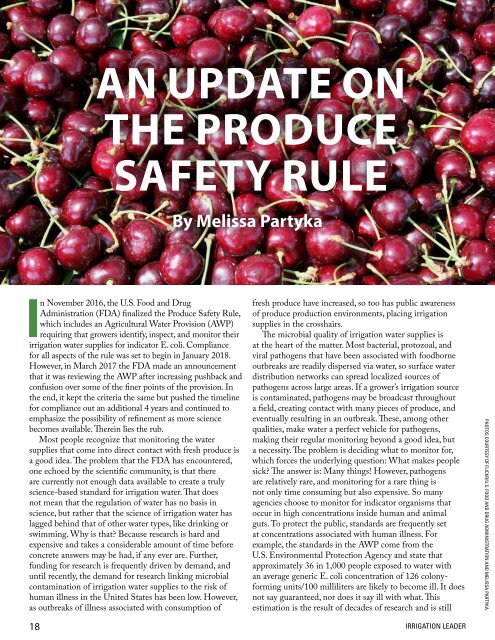il-june-18
You also want an ePaper? Increase the reach of your titles
YUMPU automatically turns print PDFs into web optimized ePapers that Google loves.
AN UPDATE ON<br />
THE PRODUCE<br />
SAFETY RULE<br />
By Melissa Partyka<br />
In November 2016, the U.S. Food and Drug<br />
Administration (FDA) finalized the Produce Safety Rule,<br />
which includes an Agricultural Water Provision (AWP)<br />
requiring that growers identify, inspect, and monitor their<br />
irrigation water supplies for indicator E. coli. Compliance<br />
for all aspects of the rule was set to begin in January 20<strong>18</strong>.<br />
However, in March 2017 the FDA made an announcement<br />
that it was reviewing the AWP after increasing pushback and<br />
confusion over some of the finer points of the provision. In<br />
the end, it kept the criteria the same but pushed the timeline<br />
for compliance out an additional 4 years and continued to<br />
emphasize the possib<strong>il</strong>ity of refinement as more science<br />
becomes ava<strong>il</strong>able. Therein lies the rub.<br />
Most people recognize that monitoring the water<br />
supplies that come into direct contact with fresh produce is<br />
a good idea. The problem that the FDA has encountered,<br />
one echoed by the scientific community, is that there<br />
are currently not enough data ava<strong>il</strong>able to create a truly<br />
science-based standard for irrigation water. That does<br />
not mean that the regulation of water has no basis in<br />
science, but rather that the science of irrigation water has<br />
lagged behind that of other water types, like drinking or<br />
swimming. Why is that? Because research is hard and<br />
expensive and takes a considerable amount of time before<br />
concrete answers may be had, if any ever are. Further,<br />
funding for research is frequently driven by demand, and<br />
unt<strong>il</strong> recently, the demand for research linking microbial<br />
contamination of irrigation water supplies to the risk of<br />
human <strong>il</strong>lness in the United States has been low. However,<br />
as outbreaks of <strong>il</strong>lness associated with consumption of<br />
<strong>18</strong><br />
fresh produce have increased, so too has public awareness<br />
of produce production environments, placing irrigation<br />
supplies in the crosshairs.<br />
The microbial quality of irrigation water supplies is<br />
at the heart of the matter. Most bacterial, protozoal, and<br />
viral pathogens that have been associated with foodborne<br />
outbreaks are read<strong>il</strong>y dispersed via water, so surface water<br />
distribution networks can spread localized sources of<br />
pathogens across large areas. If a grower’s irrigation source<br />
is contaminated, pathogens may be broadcast throughout<br />
a field, creating contact with many pieces of produce, and<br />
eventually resulting in an outbreak. These, among other<br />
qualities, make water a perfect vehicle for pathogens,<br />
making their regular monitoring beyond a good idea, but<br />
a necessity. The problem is deciding what to monitor for,<br />
which forces the underlying question: What makes people<br />
sick? The answer is: Many things! However, pathogens<br />
are relatively rare, and monitoring for a rare thing is<br />
not only time consuming but also expensive. So many<br />
agencies choose to monitor for indicator organisms that<br />
occur in high concentrations inside human and animal<br />
guts. To protect the public, standards are frequently set<br />
at concentrations associated with human <strong>il</strong>lness. For<br />
example, the standards in the AWP come from the<br />
U.S. Environmental Protection Agency and state that<br />
approximately 36 in 1,000 people exposed to water with<br />
an average generic E. coli concentration of 126 colonyforming<br />
units/100 m<strong>il</strong>l<strong>il</strong>iters are likely to become <strong>il</strong>l. It does<br />
not say guaranteed, nor does it say <strong>il</strong>l with what. This<br />
estimation is the result of decades of research and is st<strong>il</strong>l<br />
IRRIGATION LEADER<br />
PHOTOS COURTESY OF FLICKR/U.S. FOOD AND DRUG ADMINISTRATION AND MELISSA PARTYKA.


